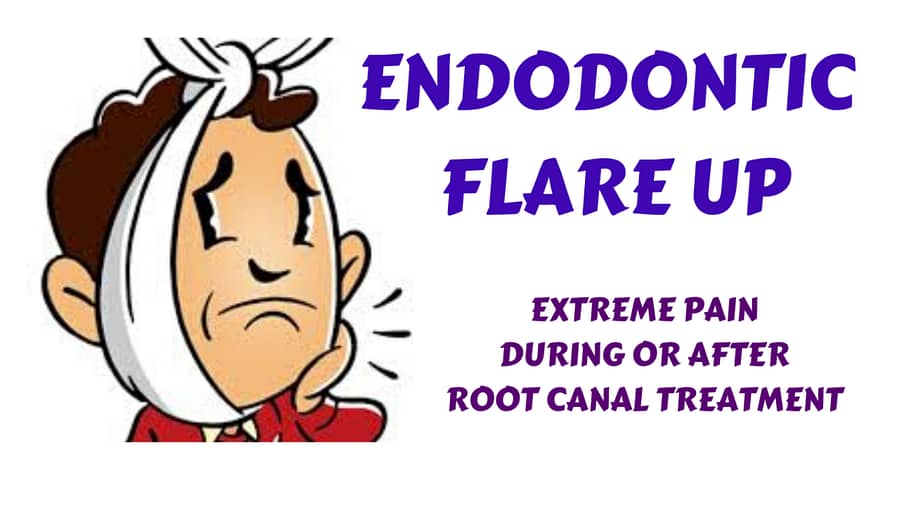let’s start from alteration of Local Adaptation Syndrome
In case of chronic pulple diseases, the inflammatory lesion is adapted to irritants but during root canal therapy, a new irritant in the form of irrigation and filling get introduced in the lesion leading to flare-ups.
Next is changes in Periapical Tissue Pressure
When pressure below the root canal increases due to excessive puss it creates pain by causing pressure on nerves. Root canal of such teeth when kept open puss comes out but in teeth with less pressure below root bacteria and other irritants get aspirated into the periapical area leading to pain.
Next one is Microbial Mechanism in the induction of flare-ups
First one is apical extrusion of infected debris:
Extrusion of microbes destroy the balance between microbial aggression and defense leading to acute periapical inflammation.
Second is changes in the Endodontic Micro Flora or in Environmental Conditions
Incomplete preparation of canal disrupts the balance between the various microbial communities within the root canal system that may favor the overgrowth of dangerous microbes, which can lead to flare-up
Next is Secondary Intraradicular Infection
It means penetration of the new microbes from the saliva into the root canal system during treatment may lead to a secondary infection and can be a cause of flare up.
Next is difficult one Increase of Oxidation-Reduction Potential
Alteration of oxidation reduction potential in the root canal during treatment may favor the overgrowth of dangerous bacteria that resist of a root canal procedure and lead to flare-ups.
Other two factors are totally theoretical and I too don’t understand them completely
First one is Effect of Chemical Mediators
Chemical mediators can be in 2 form of Cell Mediators or Plasma Mediators
Cell Mediators include histamine, serotonin,prostaglandins, plateletactivating factor and lysosomal components which may lead to pain.
The Plasma Mediators are present in circulation in inactive form and get activated on coming in contact with
irritants .For example human factor when gets activated after in contact with irritants, produced multiple effects like production of bradykinin and activation of clotting cascade which may cause vascular leakage.
Other one is Changes in Cyclic Nucleotide
cAMP helps in reducing pain by inhibiting mast cell degranulation where as cGMP increases pain by stimulating mast cell degranulation and during flare-up, there is increased level of cGMP over cAMP concentrations.
let’s move forward from this boring topic to the Management of flare-ups as
As the cause of flare-ups are multiple, many treatment options are there for the prevention and relieving of the symptoms during the root canal therapy.
Management can be divided into 2
First is Preventive and second is Definitive
In preventive management first step is Proper Diagnosis before starting RCT ,proper diagnosis of the condition should be made so as to prevent incorrect treatment that may lead to pain or swelling then Determine proper working length inaccurate measurement of the working length may lead to under or
over instrumentation and extrusion of debris, irrigants, medicaments or filling material beyond the epex.
And after that most important step is complete debridement thorough cleaning and shaping of the root canal system may decreases the incidence of flare-up. Maintenance of apical patency and crown-down preparation techniques are two important factors in the management of flare-ups. we can also do occlusal
reduction it is a good pain preventive strategy placement of intra canal medicaments in multi vist root canal treatment calcium hydroxide has been recommended as an intracanal medicament for the prevention or treatment of flare-ups. Next is closed dressing leaving a tooth open for drainage is contraindicated as it can cause contamination from the oral cavity and lead to flare-ups. last one is medications antibiotics are not
indicated in the prevention of flare-ups for healthy patient. Antibiotic should be given only in cases of medically compromised patient at high risk analgesic most commonly used drugs include ibuprofen,diclofenac sodium, ketorolac etc.
Now move forward to the other management that is Definitive Treatment
First step is drainage through the coronal assess opening
The first happened relieving the pain is to establish the drainage through the root canal when it has not been obturated or poorly obturated. Penetration of the apical foramen with the small files should be done to establish the drainage.
Next method is incision and drainage occasionally abscess present in relation to tooth communicates to vestibule. In these cases flare-ups can be managed through a combination of canal instrumentation and incision and drainage.
Proper Instrumentation working length should be re-established apical patency must be obtained and
thorough irrigation should be done.
Next is Trephination when drainage through the canal is not possible due to restorative issues or in cases of certain conditions like failing treatment or necessary correction of procedural accident a surgical trephination can be used as palliative measure. It involves the surgical perforation of the alveolar cortical plate over the root end to release the accumulated exudates to release pain.
However it is not the first line of treatment intracanal medicaments use of corticosteroid antibiotic combination as an intracanal medicament has been recommended to reduce pain especially in case of over
instrumentation.
Analgesics and antibiotics for the most patient the saves are sufficient to control pain however if the pain cannot be controlled with NSAIDs, opoid analgesics can be used to supplement with NSADIs.
